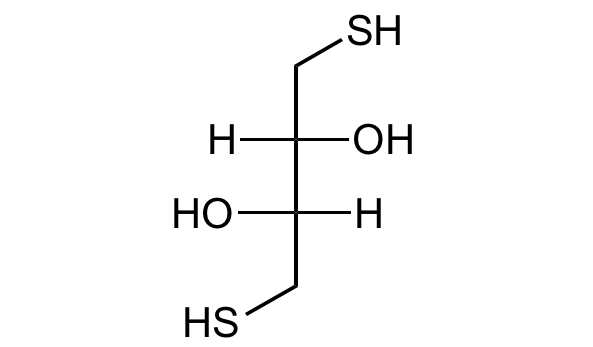
Chemical Structure
DL-Dithiothreitol
CDX-D0323
CAS Number3483-12-3
Product group Chemicals
Estimated Purity>98%
Molecular Weight154.25
Overview
- SupplierChemodex
- Product NameDL-Dithiothreitol
- Delivery Days Customer10
- CAS Number3483-12-3
- CertificationResearch Use Only
- Estimated Purity>98%
- Hazard InformationExcepted quantity,Warning
- Molecular FormulaC4H10O2S
- Molecular Weight154.25
- Scientific DescriptionChemical. CAS: 3483-12-3. Formula: C4H10O2S. MW: 154.25. DTT is a reducing agent, which once oxidized forms a stable six-membered ring with an internal disulfide bond. It is an excellent reagent for maintaining SH groups in reduced state. DTT is used as a protecting agent that prevents oxidation of thiol groups, and used as a reducing agent for thiolated DNA. DTT is frequently used to reduce the disulfide bonds of proteins and, more generally, to prevent intramolecular and intermolecular disulfide bonds from forming between cysteine residues of proteins. DTT is often used along with sodium dodecylsulfate in SDS-PAGE to further denature proteins by reducing their disulfide bonds to allow for better separation of proteins during electrophoresis. DTT can also be used as an oxidizing agent. Its principal advantage is that effectively no mixed-disulfide species are populated, in contrast to other agents such as glutathione. - DTT is a reducing agent, which once oxidized forms a stable six-membered ring with an internal disulfide bond. It is an excellent reagent for maintaining SH groups in reduced state. DTT is used as a protecting agent that prevents oxidation of thiol groups, and used as a reducing agent for thiolated DNA. DTT is frequently used to reduce the disulfide bonds of proteins and, more generally, to prevent intramolecular and intermolecular disulfide bonds from forming between cysteine residues of proteins. DTT is often used along with sodium dodecylsulfate in SDS-PAGE to further denature proteins by reducing their disulfide bonds to allow for better separation of proteins during electrophoresis. DTT can also be used as an oxidizing agent. Its principal advantage is that effectively no mixed-disulfide species are populated, in contrast to other agents such as glutathione.
- SMILES[H][C@@](O)([C@](O)([H])CS)CS
- Storage Instruction2°C to 8°C
- UN Number3335
- UNSPSC12352200


![DTT [3483-12-3]](https://www.targetmol.com/group3/M00/02/DE/CgoaEWY7OtWEdo8GAAAAACmMndM432.png)
